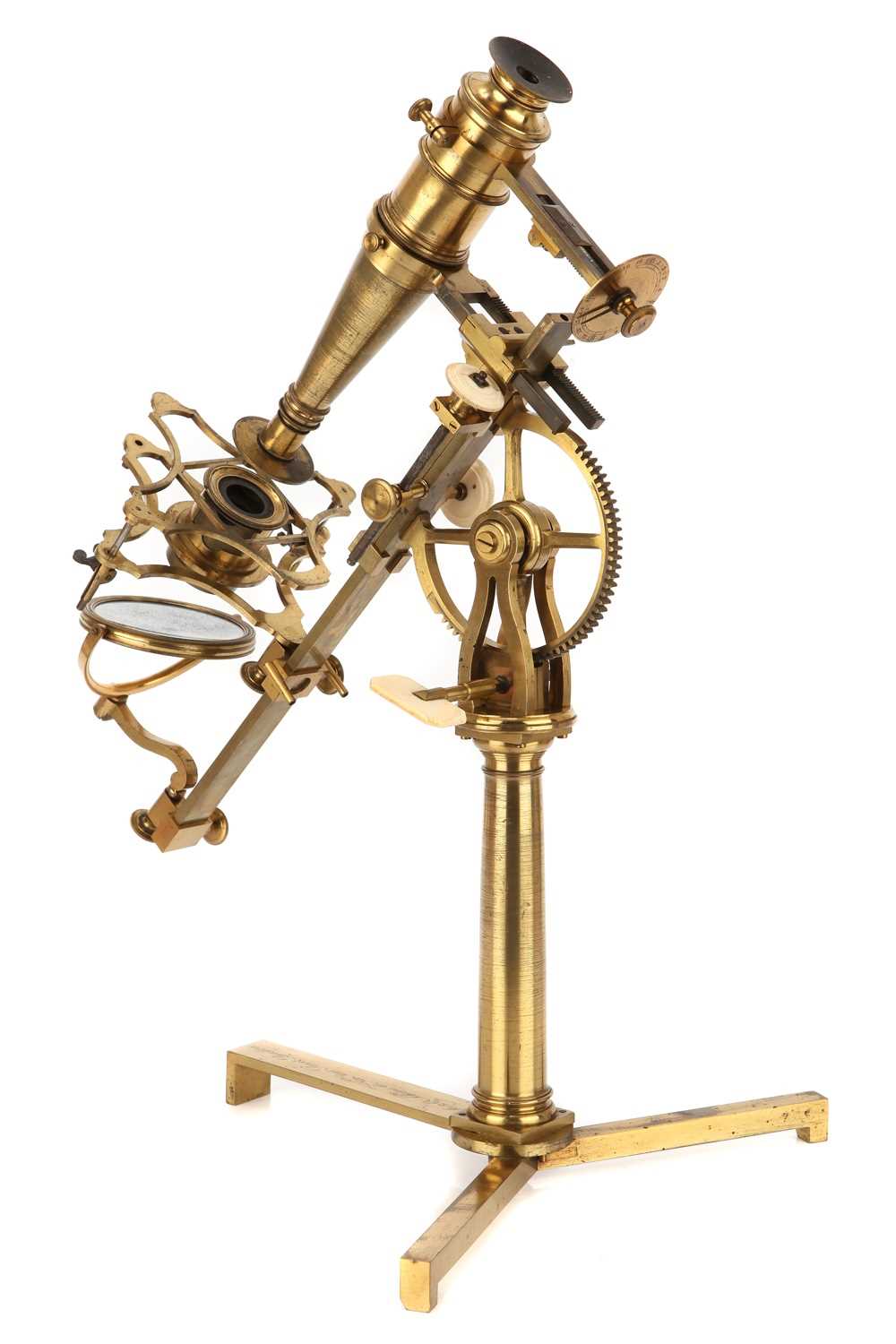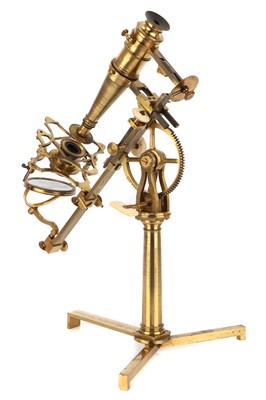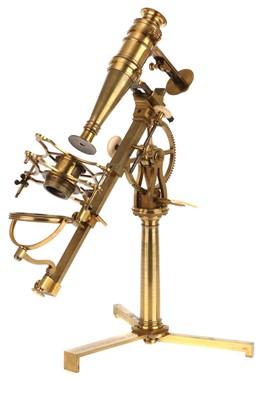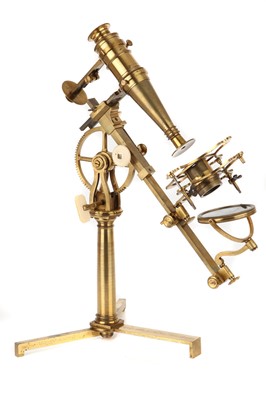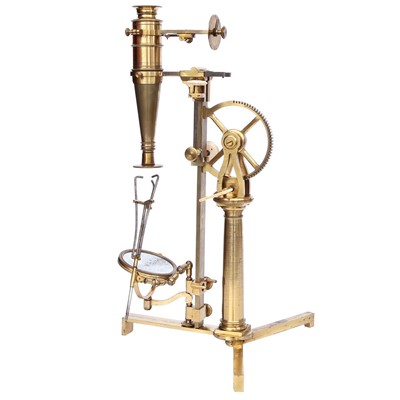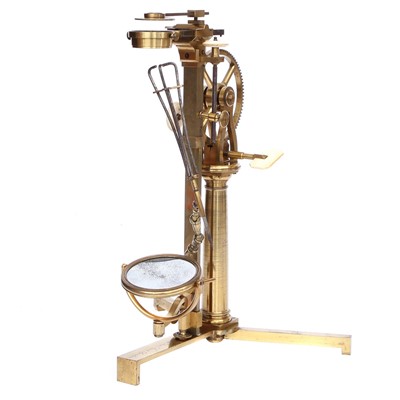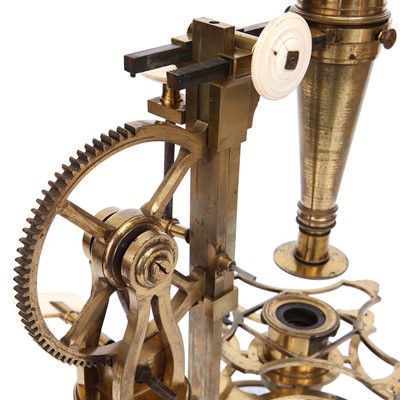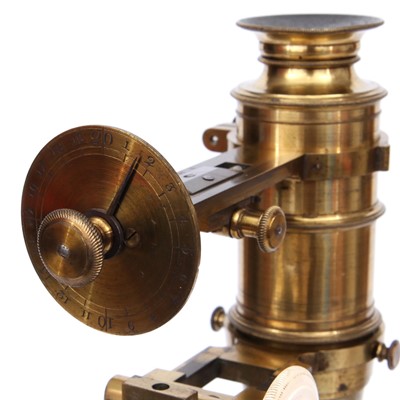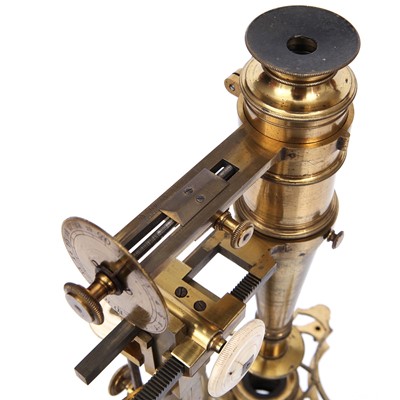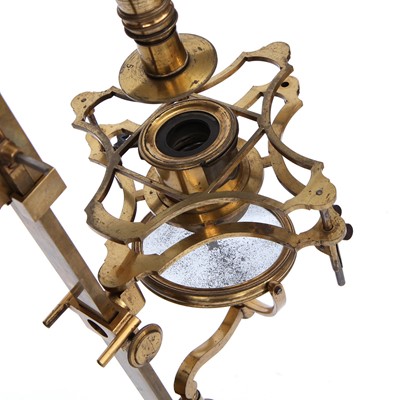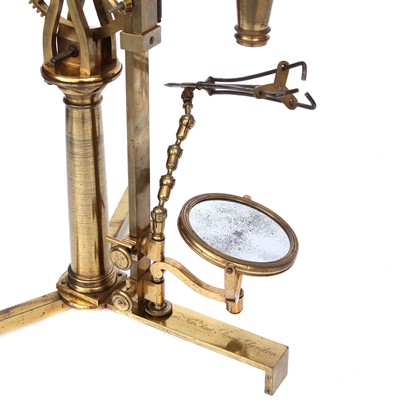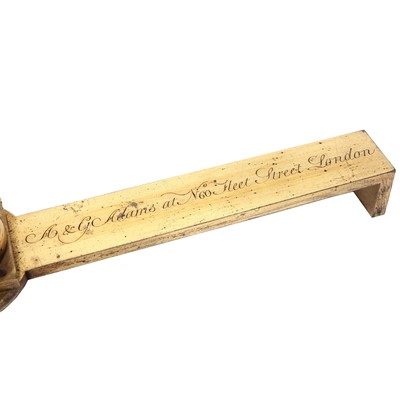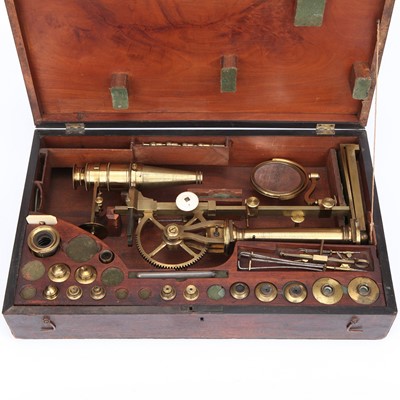26th Apr, 2018 12:00
Fine Photographica & Instruments of Science & Medicine
An Exceptionally Fine Adams' "Variable" Microscope
C.1773, English, signed A & G Adams at No 60 Fleet Street, London, standing on three folding feet two of which fold out from under the front foot bearing the signature, in the centre is a circular boss which holds the large turned architectural brass pillar, at the top is a rotating boss which holds the two ‘A’ frame supports, these hold the centre of the large geared wheel on trunnions, a worm and gear arrangement at the base is used to incline the microscope, at the base of the microscope is the large (7.6cm diameter) concave mirror in a gimbal on articulated arm that can be removed/unscrewed, above this is the support for either the stage or the articulated arm, the large stage is constructed of two sections of brass plate elegantly cut and filed into shape with adjustment via 2 blued steel wing nuts, the centre of the bottom plate holds the Bonnani-type stage in a collar, above the stage is the main course focus via rack work in-between the two sliding rectangular sectioned bars, fine focussing is to the side with an ivory wheel acting on a fine thread cut in the top of a steel rod, at the top is the limb for the compound tube with rack work to move the tube back and forth, the compound tube is located with two threaded knurled screws, the eyepiece has two lenses mounted in a fine threaded cell to allow for focus on to the micrometer needle, below this in a field lens, located in the bottom half of the conical part of the body tube is a Martin lens, The micrometer attachment fits to the eyepiece with a locating peg and screw tightened collar, the micrometer has a steel point which enters the eyepiece via the second part quick motion rack to the underside of the micrometer, the micrometer steel screw has 50 threads per inch, engraved along the top is a scale of 0 – 50 with a pointer running along the top, the circular plate fixed at right angles carries the divisions of each section of the top scale, each revolution equates to 1 20th of a section, the compound body tube can be removed and replaced with the Bonnani-type stage, into the top of the microscope is a circular hole to take the simple microscope arm, its construction allows for aquatic movement and can be used in conjunction with all of the lenses, the outfit comes with silvered leiberkuhn lenses engraved 6, 5, 4, 3 & 2, high power lenses with brass caps engraved 2 & 3, button type objectives engraved 6, 5, 3, 2 and 1, included is a rare collar allowing the objectives to be combined to make compound objectives (Clay and Court believe this to be the first time a microscope manufacturer made the provision for objectives to be used in combination), Footnotes: The Adams Variable Microscope, Adams first describes his ‘Variable’ microscope in 1771 in the fourth edition of his ‘Micrographia Illastrata’. In the preface to the book Adams writes: ‘We owe the construction of the variable microscope to the ingenuity and generosity of a noble person. The apparatus belonging to it is more convenient, more certain, and more extensive that that of any extant; consequently, the advantage and pleasure attending the observations in viewing objects through it, must be as extensive in proportion.’ Clay and Court in their book ‘History of the microscope’ suggest that the anonymity of the original designer of the microscope was to hide plagiarism in the design as Adams appeared to have copied Watkins microscope design of 1754. The focusing design was very similar to that of Martin and the optical system was almost identical. The anonymity of the nobleman that Adams refers to seems to have been given away by Sir John hill in the first edition of his book ‘The Construction of Timber’ which was published a year prior to Adams’ book in 1770. In Hills book there is a full page illustration of the variable microscope. In the text Hill states that the design of the microscope was due to his Patron and the patron of the book – Sir John Stuart Earl of Bute (1713-92). It was known that Bute had an interest in the sciences and after his death a large collection of scientific equipment was sold at auction. Ann Adams, Ann was George Adams‘ second wife. When George Senior died in 1773 his eldest son George Adams Junior had not completed his apprenticeship. In order to keep the business going Ann formed a partnership with George Junior and they traded under the name Ann & George Adams for two years until George Juniors apprenticeship was complete. He then took control of the company and the name changed to George Adams Jnr. We have been unable to find a single instrument signed by Ann and George Adams.
Sold for £105,600
Result including buyers premium
C.1773, English, signed A & G Adams at No 60 Fleet Street, London, standing on three folding feet two of which fold out from under the front foot bearing the signature, in the centre is a circular boss which holds the large turned architectural brass pillar, at the top is a rotating boss which holds the two ‘A’ frame supports, these hold the centre of the large geared wheel on trunnions, a worm and gear arrangement at the base is used to incline the microscope, at the base of the microscope is the large (7.6cm diameter) concave mirror in a gimbal on articulated arm that can be removed/unscrewed, above this is the support for either the stage or the articulated arm, the large stage is constructed of two sections of brass plate elegantly cut and filed into shape with adjustment via 2 blued steel wing nuts, the centre of the bottom plate holds the Bonnani-type stage in a collar, above the stage is the main course focus via rack work in-between the two sliding rectangular sectioned bars, fine focussing is to the side with an ivory wheel acting on a fine thread cut in the top of a steel rod, at the top is the limb for the compound tube with rack work to move the tube back and forth, the compound tube is located with two threaded knurled screws, the eyepiece has two lenses mounted in a fine threaded cell to allow for focus on to the micrometer needle, below this in a field lens, located in the bottom half of the conical part of the body tube is a Martin lens, The micrometer attachment fits to the eyepiece with a locating peg and screw tightened collar, the micrometer has a steel point which enters the eyepiece via the second part quick motion rack to the underside of the micrometer, the micrometer steel screw has 50 threads per inch, engraved along the top is a scale of 0 – 50 with a pointer running along the top, the circular plate fixed at right angles carries the divisions of each section of the top scale, each revolution equates to 1 20th of a section, the compound body tube can be removed and replaced with the Bonnani-type stage, into the top of the microscope is a circular hole to take the simple microscope arm, its construction allows for aquatic movement and can be used in conjunction with all of the lenses, the outfit comes with silvered leiberkuhn lenses engraved 6, 5, 4, 3 & 2, high power lenses with brass caps engraved 2 & 3, button type objectives engraved 6, 5, 3, 2 and 1, included is a rare collar allowing the objectives to be combined to make compound objectives (Clay and Court believe this to be the first time a microscope manufacturer made the provision for objectives to be used in combination), Footnotes: The Adams Variable Microscope, Adams first describes his ‘Variable’ microscope in 1771 in the fourth edition of his ‘Micrographia Illastrata’. In the preface to the book Adams writes: ‘We owe the construction of the variable microscope to the ingenuity and generosity of a noble person. The apparatus belonging to it is more convenient, more certain, and more extensive that that of any extant; consequently, the advantage and pleasure attending the observations in viewing objects through it, must be as extensive in proportion.’ Clay and Court in their book ‘History of the microscope’ suggest that the anonymity of the original designer of the microscope was to hide plagiarism in the design as Adams appeared to have copied Watkins microscope design of 1754. The focusing design was very similar to that of Martin and the optical system was almost identical. The anonymity of the nobleman that Adams refers to seems to have been given away by Sir John hill in the first edition of his book ‘The Construction of Timber’ which was published a year prior to Adams’ book in 1770. In Hills book there is a full page illustration of the variable microscope. In the text Hill states that the design of the microscope was due to his Patron and the patron of the book – Sir John Stuart Earl of Bute (1713-92). It was known that Bute had an interest in the sciences and after his death a large collection of scientific equipment was sold at auction. Ann Adams, Ann was George Adams‘ second wife. When George Senior died in 1773 his eldest son George Adams Junior had not completed his apprenticeship. In order to keep the business going Ann formed a partnership with George Junior and they traded under the name Ann & George Adams for two years until George Juniors apprenticeship was complete. He then took control of the company and the name changed to George Adams Jnr. We have been unable to find a single instrument signed by Ann and George Adams.
Auction: Fine Photographica & Instruments of Science & Medicine, 26th Apr, 2018
